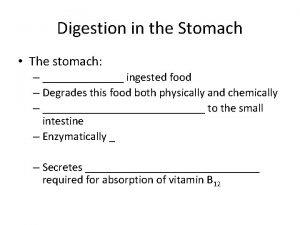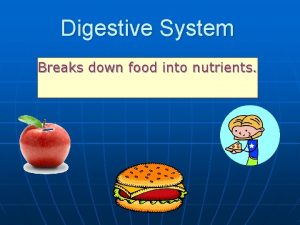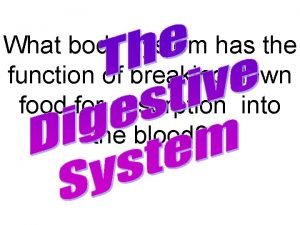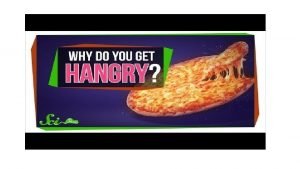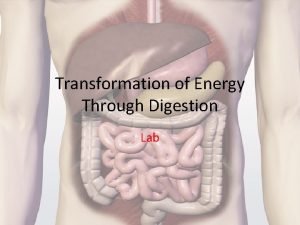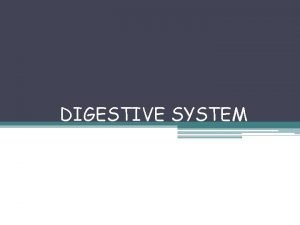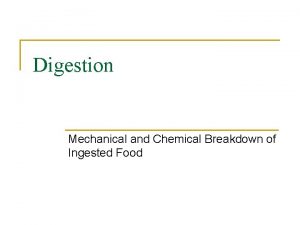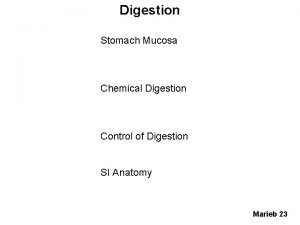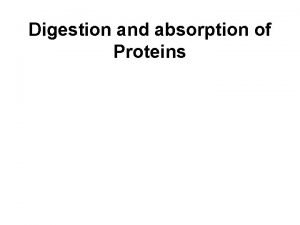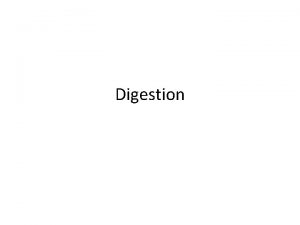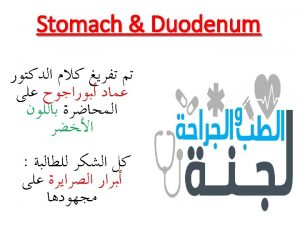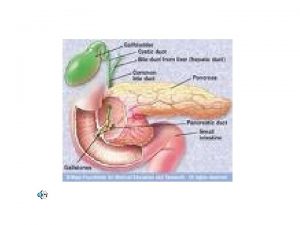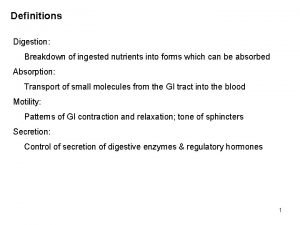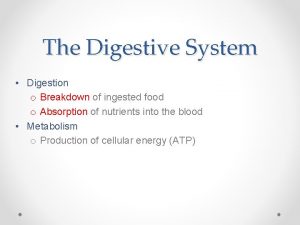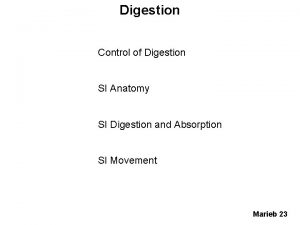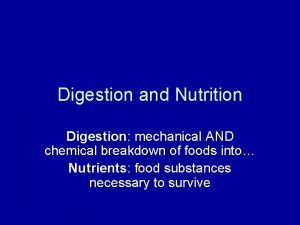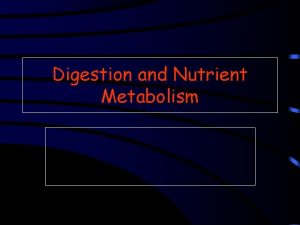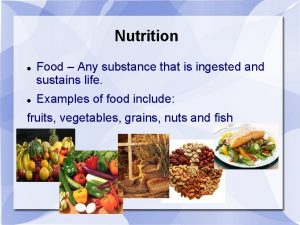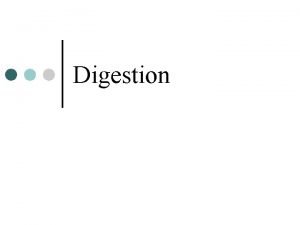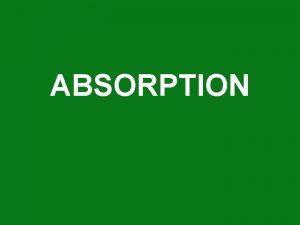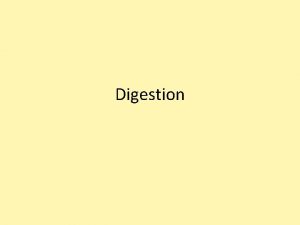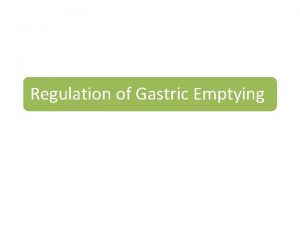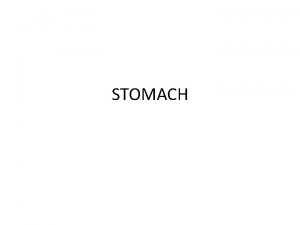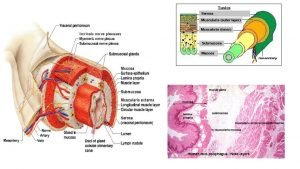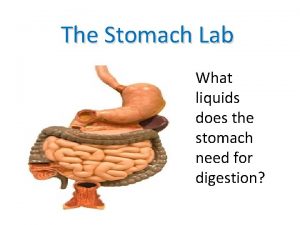Digestion in the Stomach The stomach ingested food

































- Slides: 33

Digestion in the Stomach • The stomach: – _______ ingested food – Degrades this food both physically and chemically – ______________ to the small intestine – Enzymatically _ – Secretes _______________ required for absorption of vitamin B 12

Regulation of Gastric Secretion • release of gastric juices – _____________ (reflex) phase: • prior to food entry – _____________ phase: • once food enters the stomach – _____________ phase: • as partially digested food enters the duodenum

Cephalic Phase • Excitatory events include: – – Stimulation of taste or smell receptors • Inhibitory events include: – Loss of appetite or _ – ______________ in stimulation of the _

Gastric Phase • Excitatory events include: – – Activation of stretch receptors – Activation of ______________ by peptides, caffeine, and rising p. H – Release of ______________ to the blood

Gastric Phase • Inhibitory events include: – A p. H _ – __________________ that overrides the parasympathetic division

Intestinal Phase • Excitatory phase – low p. H; partially digested food enters the duodenum and _ • Inhibitory phase – distension of duodenum, _________________, acidic, or hypertonic chyme, and/or irritants in the duodenum – Closes the _ – Releases hormones that _

Regulation and Mechanism of HCl Secretion • HCl secretion is stimulated by – – – ________________ through second-messenger systems • Antihistamines block H 2 receptors and _

Response of the Stomach to Filling • Reflex-mediated events include: – • as food travels in the esophagus, stomach muscles relax – • the stomach dilates in response to gastric filling • Plasticity – the ability to be _

Gastric Contractile Activity • Most vigorous peristalsis and mixing occurs near the pylorus • Chyme is either: – Delivered in _ or – Forced ________________ for further mixing

Regulation of Gastric Emptying • Gastric emptying is regulated by: – The neural _ – Hormonal (enterogastrone) mechanisms • These mechanisms ________________ and duodenal filling

Regulation of Gastric Emptying • ___________-rich chyme – ______________ moves through the duodenum • _________-laden chyme – digested ______________ causing food to remain in the stomach longer

Small Intestine: Gross Anatomy • Runs from pyloric sphincter to the ileocecal valve • Has three subdivisions: • • •

Small Intestine: Gross Anatomy • The _ – Join the duodenum at the hepatopancreatic ampulla – Are controlled by the _ • The jejunum extends from the duodenum to the ileum • The ileum joins the large intestine at the __

Small Intestine: Microscopic Anatomy • Structural modifications of the small intestine wall increase surface area – Plicae circulares: deep _____________ of the mucosa and submucosa – Villi • fingerlike _ – • tiny projections of absorptive mucosal cells’ plasma membranes

Small Intestine: Histology of the Wall • Cells of ______________ secrete intestinal juice • ________________ are found in the submucosa • Brunner’s glands in the duodenum secrete _

Intestinal Juice • Secreted by intestinal glands _ • Slightly alkaline • Largely water, – enzyme-poor, but _

Liver • The _____________ in the body • Superficially has _ – right, left, caudate, and quadrate • The _ – Is a remnant of the fetal _

Liver: Associated Structures • The lesser omentum _ • The _______________ rests in a recess on the inferior surface of the right lobe

Liver: Associated Structures • Bile leaves the liver via: – Bile ducts, • which fuse into the common hepatic duct – The common hepatic duct, • which fuses with the cystic duct • __________________ form the bile duct

Composition of Bile • A yellow-green, alkaline solution containing – – neutral fats, – phospholipids, – electrolytes • Bile salts are cholesterol derivatives that: – – Facilitate fat and cholesterol absorption – Help solubilize cholesterol

Bile • Enterohepatic circulation _ • The chief bile ___________ is bilirubin – waste product of _

The Gallbladder • Thin-walled, green ______________ on the ventral surface of the liver • • • – via the cystic duct – flows into the bile duct

Regulation of Bile Release • Acidic, _____________ causes the duodenum to release: – Cholecystokinin (CCK) – – into the _

Regulation of Bile Release • Cholecystokinin causes: – The _ – The hepatopancreatic _ • As a result, bile _

4 Vagal stimulation causes weak contractions of gallbladder 3 Bile salts and secretin transported via bloodstream stimulate liver to produce bile more rapidly 5 Cholecystokinin (via bloodstream) causes gallbladder to contract and hepatopancreatic sphincter to relax; bile enters duodenum 1 Acidic, fatty chyme entering duodenum causes release of cholecystokinin and secretin from duodenal wall enteroendocrine cells 2 Cholecystokinin and secretin enter the bloodstream 6 Bile salts reabsorbed into blood Figure 23. 25

Pancreas • Location – Lies deep to the greater curvature of the stomach – The ____________________ and the tail is near _

Pancreas • Exocrine function – – Acini (clusters of secretory cells) contain _________________ with digestive enzymes • The pancreas also has an _ – release of _

Composition and Function of Pancreatic Juice • Water solution of _ (primarily HCO 3–) – ______________ acid chyme – Provides ________________ for pancreatic enzymes • Enzymes are released in ________________ and activated in the duodenum

Composition and Function of Pancreatic Juice • Examples include – _____________ is activated to trypsin – Procarboxypeptidase is activated to _ • Active enzymes secreted – Amylase, lipases, and nucleases – These enzymes require __________ for optimal activity

Regulation of Pancreatic Secretion • CCK and secretin enter the bloodstream when fatty or acidic chyme enters the duodenum • Upon reaching the _ – CCK causes secretion • – Secretin causes secretion • • Vagal stimulation also causes release of pancreatic juice

Regulation of Pancreatic Secretion During cephalic and gastric phases, stimulation by vagal nerve fibers causes release of pancreatic juice and weak contractions of the gallbladder. 1 Acidic chyme entering duodenum causes the enteroendocrine cells of the duodenal wall to release secretin, whereas fatty, protein-rich chyme induces release of cholecystokinin. 2 Cholecystokinin and secretin enter bloodstream. 3 Upon reaching the pancreas, cholecystokinin induces the secretion of enzyme-rich pancreatic juice; secretin causes copious secretion of bicarbonate-rich pancreatic juice. Figure 23. 28

Digestion in the Small Intestine • As chyme enters the duodenum: – Carbohydrates and proteins are only partially digested –

Digestion in the Small Intestine • Digestion continues in the small intestine – Chyme is ______________ into the duodenum – Because it is hypertonic and has low p. H, _ – Virtually __________________ takes place in the small intestine
 Ingested food
Ingested food Digestion of food in stomach
Digestion of food in stomach Venn diagram mechanical and chemical digestion
Venn diagram mechanical and chemical digestion Starch digestion begins in the
Starch digestion begins in the Unit 2 food food food
Unit 2 food food food Eltonian pyramid
Eltonian pyramid Energy transformation in digestion
Energy transformation in digestion Which is the largest gland of the body
Which is the largest gland of the body Stomach greens and liquefies food
Stomach greens and liquefies food độ dài liên kết
độ dài liên kết Môn thể thao bắt đầu bằng chữ f
Môn thể thao bắt đầu bằng chữ f Thiếu nhi thế giới liên hoan
Thiếu nhi thế giới liên hoan Khi nào hổ mẹ dạy hổ con săn mồi
Khi nào hổ mẹ dạy hổ con săn mồi điện thế nghỉ
điện thế nghỉ Biện pháp chống mỏi cơ
Biện pháp chống mỏi cơ Một số thể thơ truyền thống
Một số thể thơ truyền thống Trời xanh đây là của chúng ta thể thơ
Trời xanh đây là của chúng ta thể thơ Bảng số nguyên tố
Bảng số nguyên tố Tỉ lệ cơ thể trẻ em
Tỉ lệ cơ thể trẻ em Vẽ hình chiếu vuông góc của vật thể sau
Vẽ hình chiếu vuông góc của vật thể sau Các châu lục và đại dương trên thế giới
Các châu lục và đại dương trên thế giới Thế nào là hệ số cao nhất
Thế nào là hệ số cao nhất Hệ hô hấp
Hệ hô hấp Tư thế ngồi viết
Tư thế ngồi viết Hình ảnh bộ gõ cơ thể búng tay
Hình ảnh bộ gõ cơ thể búng tay đặc điểm cơ thể của người tối cổ
đặc điểm cơ thể của người tối cổ Cái miệng xinh xinh thế chỉ nói điều hay thôi
Cái miệng xinh xinh thế chỉ nói điều hay thôi Mật thư anh em như thể tay chân
Mật thư anh em như thể tay chân ưu thế lai là gì
ưu thế lai là gì Tư thế ngồi viết
Tư thế ngồi viết Chó sói
Chó sói Thẻ vin
Thẻ vin Thể thơ truyền thống
Thể thơ truyền thống Các châu lục và đại dương trên thế giới
Các châu lục và đại dương trên thế giới
